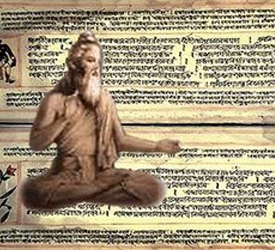Truth can not be suppressed and always is the ultimate victor.

Vedic Concepts
Veda is divided into four major parts viz, Samhitas (prayers), Brahmanas (rituals), Aranyakas ( meditations) and Upanishads (The knowledge of self). The first three (Samhita, Brahmana & Aranyaka) are collectively called as Veda Purva (Starting) and the last one Upanishad is called as Veda Anta (ending) or Vedanta. The Veda Purva is also referred as Karma Kanda (Portion dealing with Rituals & Activities) and Vedanta as Jnana Kanda (Portion dealing with The Knowledge of Supreme Self).
Puranas and Upa puranas
Puranas are a separate class of works that is an important part of the Vedic studies. Since they elaborate real events of the past and also higher philosophical truths with large number of stories and anecdotes, they have come to be regarded differently in modern times as stories, fables or mythologies.
The word Purana means past. They deal with a variety of subjects that happened in the past and hence the name. In essence, Puranas are encyclopedias for scholars and lay persons alike as to ancient and medieval Hindu religious practices, mythology, history, geography, royal dynasties, cosmology and literature.
There are two schools of thought with respect to the purpose and relevance of the Puranas. One school holds that the only purpose of the Puranas is to explain the higher philosophies contained in the Vedas through a series of stories and anecdotes. Hence, according to this train of thought, the Puranas are meant only for laymen. On the other hand, there is a school of thought that holds that the Puranas are independent treatises meant for both the scholars and the laymen alike. The Puranas, for example, contain detailed explanations of various worlds in the cosmos, flora and fauna of Indian sub-continent over thousands of years, the historical accounts of various kingdoms through centuries, etc., and all of them serve as wonderful guides to scholars of different fields such as Indologists, Archaeologists, Botanists, Historians et.al. Also there is a thought which holds that the Puranas are actual past records though it is pretty difficult to substantiate that despite the fact that there is a verse in Matsya Purana stating that it contains records of the past.
The Puranas are divided into MahaPuranas and UpaPuranas. There are eighteen MahaPuranas and eighteen UpaPuranas. Each Purana is devoted to a particular deity. The eighteen MahaPuranas amount to total of 400,000 granthas or stanzas. There is an interesting anecdote with respect to this number. The eighteen Puranas are not independent works created by Veda Vyasa. Originally there was only one Purana containing one billion verses. Seeing the inability of the people, in Dwapara Yuga, the Lord Himself directed Veda Vyasa to abridge them to 400,000 verses divided over eighteen sections and these eighteen sections came to be known as eighteen MahaPuranas. Also there is a separate classification, of course which was made much later, of eighteen MahaPuranas into three sub-divisions of six each, based on Sattva, Rajas and Tamas, the three primordial qualities of the Nature itself.
Primarily, the Puranas deal with five subjects, though overall, they are meant to promote four-fold classification of human existence, namely, Purusarthas – Dharma, Artha, Kama and Mokṣa. These five subjects are,
1) Sarga or Primary Creation
2) Prati-sarga or Secondary Creations and Dissolution
3) Vamsa or Genealogy of Gods and Patriarchs
4) Manvantaras or Reigns of Manus and
5) Vamsanucharita or Tales of Royal families.
The most important function of Puranas is that they act as a magnifying glass and elaborate the pithy and obscure sayings of the Vedas, thereby enabling a student of Vedas to easily comprehend higher truths and also remember them lifelong. If the student is not able to understand certain philosophical truths contained in the Vedas and Upanishads, then he/she can turn to Puranas for easier understanding of the same principle that is elaborated in Puranas with the help of certain historical events and stories. For example, the Vedas say ‘Satyam Vada’ – ‘Speak the truth’. Puranas and Ithihasas enable the student to grasp this pithy saying in its entirety through the stories of Harishchandra and the like.
In addition to the eighteen MahaPuranas and eighteen UpaPuranas, there are SthalaPuranas [detailed historical accounts depicting the greatness of a particular kṣetra or holy place] and small puranas dealing with the life of devotees of various gods. Some of these find place along with great many popular slokas and Stotras in the MahaPuranas and UpaPuranas, while others remain as separate books.
The eighteen MahaPuranas are
1) Brahma Purana
2) Viṣnu Purana
3) Padma Purana
4) siva Purana
5) srimad Bhagavata MahaPurana
6) Narada Purana
7) Markanḍeya Purana
8) Agni Purana
9) Bhaviṣya Purana
10) Brahma Vaivarta Purana
11) Liṅga Purana
12) Varaha Purana
13) Skanda MahaPurana
14) Vamana Purana
15) Kūrma Purana
16) Matsya Purana
17) Garuḍa Purana
18) Brahmanḍa Purana.
The names of the eighteen UpaPuranas are
1) Sanat Kumara
2) Narasimha
3) Naradeeya
4) siva Dharma
5) Durvasa
6) Kapila
7) Manava
8) Usanas
9) Varuna
10) Kalika
11) Samba
12) Saura
13) aditya
14) Maheswara
15) Devi Bhagavatam
16) Vaṣista
17) Viṣnu Dharmottara and
18) Nilamata.
